~ THE TURNING OF THE WHEEL ~
Yule/Winter Solstice 2009
Issue #5 is Here!
By the Hum of Ullr’s Bow: Winter Songs Compilation CD is
included with the magazine and is also available for purchase separately.
Artists on the compilation CD include:
• A Minority of One • Allerseelen • Andrew King • At the Head of the Woods
• Beastianity • Hamramr • Irij • Ironwood • Ruhr Hunter• Sangre Cavallum • Sieben • Steve von Till
• Svarrogh • Waldteufel • Wardruna
(You can read more about the artists here).
Hex needs your help! This is a community-supported not-for-profit publication.
You can support us by clicking the image above and ordering magazines,
CDs, and prints, and by spreading the word to all like-minded folk!
* * * * * *
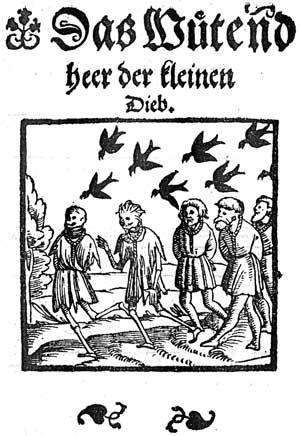 Wütendes Heer, Druck Basel, 1569
Wütendes Heer, Druck Basel, 1569
The Hunt Rides Tonight
Fasten your windows and bolt all your doors,
Draw tight your curtains and shades;
Keep the lights burning and stay out of sight,
For the Yuletide is turning;
The Hunt rides tonight.
Hordes of dead heroes from long-ago wars
Ride forth from Valhalla this eve,
And there’s blood in their eyes and they lust for a fight,
They will seize the unwary;
The Hunt rides tonight.
With shrieks and shrill hollers they take to the skies,
Like a curtain of mist they advance,
Riding the storm winds, the furious host,
They sweep down on the slumbering lands.
With their horses’ eyes burning and hounds at their heels,
The dead hunters seek out their prey,
Ripping down trees and tearing down walls,
Raining down doom on their way.
Scattering grain and shattering lives,
They lay waste to all in their path.
Ghostly hands tear down what humans have built,
Leaving destruction behind.
But the hunters sow seeds in the deep-frozen earth,
So that next year the crops will be kind.
Lock up your children and hide your fair wives,
Stay inside safe by the fire,
Set out your offerings for all the wild wights,
For the Yuletide is turning;
The Hunt rides tonight.
For the huntsmen seek food and the huntsmen seek lives
And blood is the mead in their horns,
They will sweep away all that is left in the fields,
So new seeds can be sprouted;
The Hunt rides tonight.
As for me, I will stand outside on the steps,
With the wind whipping chill through my hair,
Watching the skies as the clamor draws near
With the howling of wolves and the clashing of spears,
Watching the skies until He appears,
Riding the storm on His eight-legged steed,
Leading the dead through the skies,
Riding the winds at hurricane speed,
With two wolves at His side and His cloak of blue-black.
And a terrible gleam in His eye.
Wodanaz, come to me, take me away,
For I am your rightful prey;
Lift me beside You and off we will ride,
Leading the dead through the skies.
Fasten your windows and bolt all your doors,
All those who want to stay safe.
But I’m sworn to the Huntsman, and with Him I will fly,
Riding the storm winds;
The Hunt rides tonight.
Wodanaz, drive Your spear into me,
Drink deep of my heart’s blood so red;
For the Hunt’s in my blood and there’s fire in my head
And I give myself freely;
The Hunt rides tonight.
~ Laure Beth Lynch
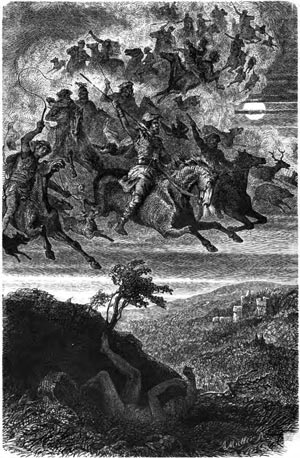 Wodan’s Wilde Jagt by F. Heine
Wodan’s Wilde Jagt by F. Heine
* * * * * *
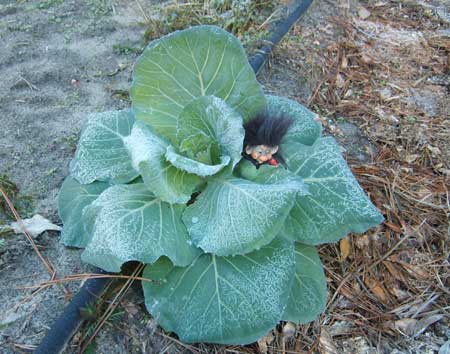
.:The Winter Evergreens: Heathen Coleworts :.
This time of year is all about Winter Evergreens! Everywhere you look you can find mistletoe, holly, and “holiday” trees like pines, firs, and spruces. However, these are not the only Evergreens to reign in Winter. This year, look for some other regal Winter Evergreens: no, not Popeye and his can of spinach, but the coleworts! These greens, like the more well known Winter Evergreens mentioned above, have a long history, with evidence of cultivation all over Europe. Coleworts were known to the early Celtic peoples and widely cultivated by the Romans and Greeks – and probably long before that, since their wild relatives can be found from one end of Europe to another.
You’ll find colewort “greens” in the produce department of your local grocery store – they’re known today as kale and collards. Both hail from the plant family Brassicaceae, also known as Cruciferous (both names are still valid today), and these names translate to mean “cross bearing”, in reference to their four-petal, cross-shaped flowers.
The Brassicaceae family contains 330 genera, including the genus Brassica, species oleracea, cultivar Acephala (or non-heading) Group, in which kale and collards are included.
The brassicas contain more agricultural and horticultural crops than any other genus with more than 30 wild species and hybrids. The species oleracea further contain 7 major cultivars:
Acephala Group – kale and collard greens (Acephala = “without a head”)
Alboglabra Group – Chinese broccoli
Botrytis Group – cauliflower, Romanesco broccoli, broccoflower
Capitata Group – cabbage
Gemmifera Group – brussels sprouts
Gongylodes Group – kohlrabi
Italica Group – broccoli
A wort known as cole or something similar was known all over Europe. The Online Etymology Dictionary notes that in Old English it was cawel, Old Norse kal, from Latin caulis, “stem, stalk, cabbage;” Italian cavolo, Spanish col, Old
French chol, French chou; also borrowed in Germanic: Swedish kal, Danish kaal, German kohl, Dutch kool. Kale is from the Middle English cawul.
The kale plant is also known as borecole today, a name which most likely originates from the Dutch boerenkool (farmer’s cabbage), while the name collard is said to derive from the Anglo-Saxon coleworts or colewyrts (cabbage plants).
Kale and collards are very similar to their wild ancestors from all around Eurasia, known as both Wild Cabbage and Wild Mustard, which are also non-heading.
Medicine and Magic:
If you aren’t familiar with kale and collards you should be. Nicholas Culpeper (1616-1654), in Culpeper’s Complete Herbal, dedicates nearly two pages to the cabbage’s and colewort’s numerous health benefits: some of the uses he describes anticipate recent scientific research.
These greens are tasty, as easy to prepare as spinach, versatile, and rich in nutritional and health promoting properties. Vegetables contain vitamins and minerals, but also phytonutrients – something science is very excited about. Coleworts seem to be the kings of nutrition; for example, kale (which seems to get most of the research of the coleworts) has seven times the beta-carotene of broccoli!
Kale has recently been labeled one of the most health-promoting of all known vegetables. It contains generous amounts of vitamins, minerals, and various antioxidants (which work to disarm free radicals before they can damage DNA, cell membranes, and fat-containing molecules such as cholesterol), but is also loaded with those phytonutrients. New research is revealing that the phytonutrients in crucifers, such as kale, work at a much deeper level in the body than antioxidants. These compounds actually signal our genes to increase production of enzymes involved in detoxification of the body, by communicating with the liver!
Studies show that cruciferous vegetables, and kale in particular, are associated with many instances of intense health-promoting benefits. They are known to lower the rates of cancers, including lung, colon, breast, bladder, prostate, and ovarian. Most studies seem to show remarkable results. One such study showed that those eating 28 servings of vegetables a week had a 35% lower risk of prostate cancer, but those consuming just 3 or more servings of cruciferous vegetables each week had a 44% lower prostate cancer risk, and a 49% drop in colorectal cancer risk. In another study, non-smokers eating cruciferous vegetables lowered risk of lung cancer by 30%, while smokers who regularly consumed cruciferous vegetable reduced lung cancer risk an amazing 69%!
Kale also rates high on the ORAC (Oxygen Radical Absorbency Capacity) scale. Oxidation from oxygen is the primary cause of aging and ORAC foods are high in antioxidants. Foods with high ORAC scores appear to slow down the aging of molecules in the body and brain that would otherwise become damaged or diseased. Many people have reported curing themselves of ailments purely through eating diets consisting only of such antioxidant rich foods. High ORAC foods include kale, prunes, raisins, black raspberries, spinach, pomegranates, and Acai berries.
At the Hearth:
In the garden, kale and collard greens are harvested a few leaves at a time, starting from the base of the plant. Grasp the lowest stem and bend it down near the stalk: it should snap right off. New leaves continually form in the center, so leave a few of these leaves on the plants for a continuous harvest. Once the weather warms, each plant will send up
a stalk that produces small flowers with the typical Cruciferous cross-shaped petals and distinctive long, thin seed pods of Brassicas. All of these parts are edible with varying degrees of spiciness. Plants are sold in most garden centers throughout the fall, winter, and spring.
Brassicas prefer cooler temperatures and are more cold-hardy than any other vegetable, tolerating freezing temperatures as low as 20° F. The cold actually helps the greens taste milder and sweeter. Kale and collards
can grow in most soils, or in pots as long as they are well drained. They are also fairly pest free and seem less bothered by disease than other cabbage family plants. Collards are various shades of dark green, while kale can be anywhere from light to dark green and even shades of red to violet-green. Decorative kale is often used in landscaping
and, as long as it is not covered with pesticides, this kale is also edible and often mild.
Reap the benefits of kale and other brassicas by consuming 3-5 servings a week: one serving is 1 cup of cooked greens. For optimal results from cruciferous vegetables like kale, be sure to choose organically grown varieties (their phytonutrient levels are much higher than industrially grown), and steam lightly to retain the most vitamins, minerals and phytonutrients.
Preparing Coleworts:
Preparing greens growing up meant opening a can of Popeye’s best; as an adult I was introduced to the coleworts, kale and collards, in vegetable gardens. Today our greens are usually coleworts from our own garden. We start by cleaning the leaves well: greens can be very sandy. Some women in the southeast US where I live claim they put greens in the
washing machine rinse cycle – I haven’t tried it but if large quantities were being preserved that might be something to consider. If your greens aren’t organically grown see the note below about removing pesticides. [Editors note: when I clean greens I often do it by putting them into a pillow case, going outside, and whirling it around like a windmill. It looks funny, but it works really well. ~ Arrowyn]
Once cleaned, the leaves can then be chopped with their mid-stems on or off. To remove the stem, cut it out; or better yet, pull out the center rib from each leaf. To do this, grasp the stem in one hand and with the other hand place the thumb on one side of the stem and the fingers on the other side of the stem. Then, while pulling the stem up, pull down with the leaf hand and let the stem separate from the leaves.
The stems can be chopped and added with the greens or saved to be added to the soup or stew pot. Cut or tear each leaf into irregular pieces about 2 to 3 inches or so in size.
To cook them try steaming for the best nutrient retention. Alternately, boil the greens in enough water to barely cover the bottom of the pot: greens make their own liquid when they start cooking.
Cover and steam or simmer for about 15 minutes; taste for desired degree of done-ness. Remove lid, cook down liquid, and add butter or olive oil; for a more traditional southern style, use smoked or cured pork or pork fat. Season to taste. Some people add a few drops of vinegar to coleworts as a seasoning at the table.
Two Long Term Storage Options:
Frozen Kale/Collards
After cleaning kale it can be frozen for later use before or after blanching or cooking. Fresh greens take up more space in the freezer. Use within 3 to 4 months. Try using it in recipes calling for spinach.
Dehydrated Kale/Collards
Another idea for preserving greens is to dry them and later grind them to add to other foods for flavoring and added nutrition. Use a food dehydrator or a low oven to dry them completely. Find an easy recipe for dried and seasoned crispy kale used as a snack or a seasoning at I Heart Kale.
NOTE: Removing Pesticides and Residue from Vegetables:
Kale has been noted as one of the top 10 most pesticide covered food crops! If possible, grow your own or purchase organically grown. If this isn’t possible try a diluted hydrochloric acid wash:
Fill a clean sink with barely warm water. Add 4 Tablespoons of salt and the juice of 1/2 a lemon. Soak and swish vegetables in this mixture from 2 to 10 minutes, depending on how fragile the food is. With fresh kale and collards’ substantial leaves, rub your fingers over each leaf, then rinse.
It is important to be aware that dark green leafy vegetables grown in nitrogen-fertilized soils tend to concentrate this chemical in their tissue. These compounds can then be transformed into carcinogenic nitrates and nitrosamines in the intestines.
If you haven’t tried these two Heathen Evergreens you are way overdue. Popeye, being a man who loved nutritious greens and his pipe, would have certainly switched, had he known how good the coleworts were for him.
~ Teresa Luedke
Further Reading/References:
Victor Boswell, “Our Vegetable Travellers,” aggie-horticulture.tamu.edu/plantanswers/publications/vegetabletravelers/index.html
Nicholas Culpeper, Culpeper’s Complete Herbal (Exeter: A, Wheaton and Company, undated).
Sally Fallon and Mary Enig, Nourishing Traditions, 2nd Ed. (Washington: New Trends Publishing, 2001).
I Heart Kale, iheartkale.blogspot.com
“Kale”, The World’s Healthiest Foods, www.whfoods.org/genpage.php?tname=foodspice&dbid=38
Online Etymology Dictionary, www.etymonline.com
* * * * * *

•OTHALA•
Old English Rune Poem
Éþel (Homestead) is over-dear to each man,
if he may there justice and courtesies
enjoy in a mansion in frequent prosperity.
~
Rune poem translation by Sweyn Plowright
http://www.mackaos.com.au/Rune-Net/Primer/
Winter was, historically speaking, the time of year when home mattered most. Without warm shelter, without carefully prepared provisions, the folk of Old Europe would not have lasted very long. Much of their efforts each year were spent preparing a good dwelling (including food stores and fuel) to protect them through the brutality of winter.
It therefore seems worthwhile, given the season, to reflect on what home might mean to us. Obviously there is the “mansion” – in whatever form it may take – in which we live. Hopefully it is sufficient enough for our needs that we feel fond of it.
Let us explore a little further than this literalism. The Old English Rune Poem reminds us that an important part of having a good home is that we enjoy “justice and courtesies” – that is to say, that we have good people around us, and a reasonably ordered society. Home is not worth all that much without our loved ones and our community!
Following that thread through, however, it seems that if a good home depends on our having good relationships – well, what sustains those to whom we relate, if not other relationships? Soon we find that what seemed like a very localised concept – the homestead – is actually just one node in a vast and interconnected social web. Indeed,
we are all dependent – in admittedly distant ways – on people we never have and never will meet, and this was also true (though perhaps with less intensity) for the old folk of Europe.
This idea runs even further, however. We depend not just on other human beings for the prosperity and enjoyment of our homes, but on the natural world too. We depend on the magic of the sun, from which our food, energy, and indeed the whole planet are derived; on the vast and complex ecosystems in which our (sadly often needlessly destructive) human settlements reside; on the very soul of the land, sea, and sky that we find around us, the spirits and custodians that embody the natural world.
Once our imagination has ranged this far, we realise that the occasional association of the rune Othala with Midgard is perhaps quite appropriate. Home might refer to the dwelling wherein we retreat from winter’s claws; yet even those claws are a part of the greater home, the world as a whole.
What are the consequences of following this thought? The more curious we are about the often invisible relationships between people, spirits, and things, the deeper our understanding of “homeliness” will become. The more we act with a consciousness of the vast causal matrices that nourish and support our own personal home, the more prosperous and hale our lives will be. I am trying to get at something that seems paradoxical at first: by appreciating the big picture we actually strengthen our individual existence; by appreciating the interconnections between things we actually strengthen our own localised uniqueness.
To rework John Donne’s famous line: no home is an island. Take the time this Yule, as you retreat into the darkness of winter, to learn more about the many relationships that sustain your well-being, be they social, environmental, material, historical, or spiritual. You might find that the more you expand your definition of home, the more “over-dear” your own special place might become…especially when such reflections remind you that home is something that many folk cannot so easily take for granted…
On reflection, these comments seem particularly relevant in the light of the seemingly weak outcome from the Copenhagen climate change summit…
* * * * * *
FINNISH PINWHEEL COOKIES
JOULUTORTUT

This is a reprint from a couple years ago. But it is well worth repeating!
Ingredients
3 c. flour (whole wheat pastry or spelt)
1 t. cinnamon
1 t. nutmeg
1 t. baking powder
1 1/2 c. heavy cream
1/4 c. maple syrup or honey
dash vanilla
1 c. soft butter
2 c. pitted prunes chopped
water
2 T. lemon juice
1/4 c. honey or raw sugar
Mix together the flour, baking powder, cinnamon, and nutmeg in a large bowl. Whip the cream, syrup, and vanilla until thick (like whipped cream topping). Add cream to the flour and mix until little balls form. Then knead the butter in, with your hands, until it forms a smooth dough. Wrap in a bag and chill for one hour.
Put chopped prunes in pan with lemon juice and just enough water to keep it from burning, simmer on medium heat, adding water as needed, until it makes a thick jam, then add honey or sugar.
Preheat oven to 400 degrees. Take 1/2 the dough and roll out on a floured board, fold into thirds and roll again into a 1/4″ thick rectangle. Cut edges into a straight line, then cut into squares 2-3 inches wide depending on how many you want. Make slits in the dough as shown in the diagram. Put a spoonful of prune jam in the center of each square. Then take one corner of a square and fold it to the center, following on all four sides so that it makes a pinwheel shape. This sounds harder than it is. Put the cookies on a lightly buttered cookie sheet. If desired, sprinkle a bit of raw sugar on the top of each. Bake for 7-10 minutes, or until the tips are just browned, then cool. Enjoy!
~ Arrowyn Craban
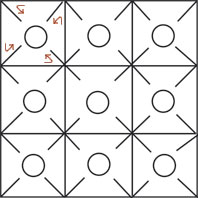 cookie diagram
cookie diagram
* * * * * *
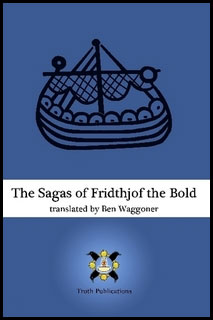
The Sagas of Fridthjof the Bold
The Troth has just published a second volume in its series of translated
Old Norse sagas: The Sagas of Fridthjof the Bold.
http://www.lulu.com/content/8084173
The Saga of Fridthjof the Bold (Friðþjófs Saga Inn Frækni) is a fornaldarsaga, or “saga of old times,” set in the legendary past, but probably composed in the 1300s. It was the first saga to be completely translated into English, back in 1839. It was probably the most popular saga in the 19th century, for its scenes of heroism, romance, and magic, and especially for the love story between the hero Fridthjof and his beloved Ingibjorg. Fridthjof’s Saga
inspired operas, symphonies, paintings, songs, and epic poems, notably Esaias Tegnér’s epic cycle Frithiof’s Saga, a foundation of modern Swedish poetry that became internationally famous in its own right.
Fridthjof’s Saga was largely forgotten in the 20th century – the last translation into English was published in 1928 and has long been out of print, and the various 19th-century translations are written in a rather tricked-out, archaic style. But I thought the saga just might deserve a fresh translation and a new look – partly because it’s a fun story, and partly because it was a major influence (if not quite historically accurate) on our cultural conceptions of what the Vikings were like.
This book also includes my translations of the “prequel” to Friðþjófs Saga, the rambling, swashbuckling Þorsteins Saga Víkingssonar, The Saga of Thorstein Vikingsson; and a “sequel,” Víkars þáttr, The Tale of King Vikar, which gives information on Fridthjof’s descendants. And there’s plenty of notes and commentary for those who like that sort of thing, giving cultural and historical background on this sequence of sagas.
The Sagas of Fridthjof the Bold will eventually be listed on Amazon.com, Barnesandnoble.com, and other online retailers – that’s in the works, and may take a few weeks. But it is available now, directly from Lulu.com, in print (US$12.99) or as a download (US$5). Check it out!
~ Ben Waggoner, Publications Director, The Troth.
* * * * * *
: Issue Three Almost Gone! :
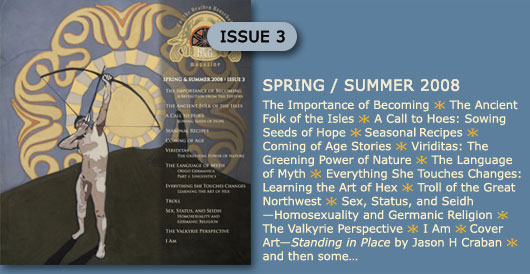
Issues One, Two, and Four are sold out!Only limited
numbers of Hex Issue Three remain…
Order at:
www.hexmagazine.com/subscribe.htm
* * * * * *
Until Imbolc, may you and your
household be blessed and kept. Hail!
~ HEX Magazine
* * * * * *
We are currently looking for:
• submissions for e-zine content
• funding
If you are interested in applying or have any suggestions,
contact: info@hexmagazine.com
* * * * * *
Due date for Winter 2010 submissions is Spring Equinox 2010 submissions@hexmagazine.com
Support your community while exposing like-minded
folk to your goods and services!
Advertisements must be relevant to HEX readers, and inclined toward a Heathen aesthetic. Prices listed are for completed AD files. If you need additional graphic design, we can help. Just contact us about our design fee.
AD space is now available in the newsletter for $10 a run.
Contact info@hexmagazine.com if you are interested.
>I< HEX >I<
www.hexmagazine.com
> Please forward to all interested and relevant parties <



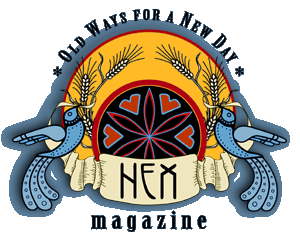

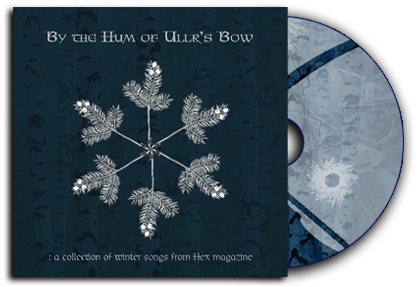






Leave a Reply